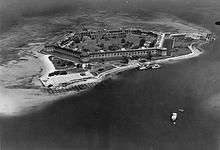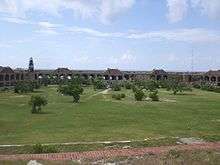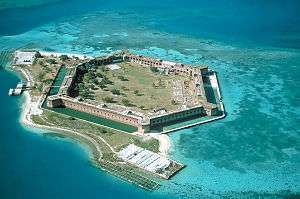Fort Jefferson (Florida)
| Fort Jefferson, Florida | |
|---|---|
| Unincorporated community | |
|
Fort Jefferson is no longer in use as a military facility and is currently part of the Dry Tortugas National Park. | |
| Coordinates: 24°37′41″N 82°52′23″W / 24.628°N 82.873°W | |
| Country |
|
| State |
|
| County | Monroe |
| Time zone | Eastern (EST) (UTC-5) |
| • Summer (DST) | EDT (UTC-4) |
|
Fort Jefferson National Monument | |
  | |
| Location | 68 mi. W of Key West, in Gulf of Mexico, Dry Tortugas Islands, Florida |
|---|---|
| Area | 47.125 acres (19.071 ha) |
| Built | 1847 |
| NRHP Reference # | 70000069[1] |
| Added to NRHP | November 10, 1970 |
Fort Jefferson is a massive but unfinished coastal fortress. It is the largest brick masonry structure in the Americas,[2][3] and is composed of over 16 million bricks. Among United States forts, only Fort Monroe in Virginia and Fort Adams in Rhode Island are larger. The fort is located on Garden Key in the lower Florida Keys within the Dry Tortugas National Park, about 70 miles (110 km) west of the island of Key West. The Dry Tortugas are part of Monroe County, Florida, United States.
Geography
It is located at 24°37′41″N 82°52′23″W / 24.628°N 82.873°W, its elevation 0 feet (0 m).
History
Construction
In late December 1824 and early January 1825, about five years after Spain sold Florida to the United States for $5 million, U.S. Navy Commodore David Porter inspected the Dry Tortugas islands. He was on the lookout for a site for a naval station that would help suppress piracy in the Caribbean. Unimpressed with what he saw, he notified the Secretary of the Navy that the Dry Tortugas were unfit for any kind of naval establishment. He reported that they consist of small sand islands a little above the surface of the ocean, have no fresh water, scarcely enough land to place a fortification, and in any case are probably not solid enough to bear one.
While Commodore Porter thought the Dry Tortugas were unfit for a naval station, others in the U.S. government thought the islands were a good location for a lighthouse to guide ships around the area's reefs and small islands. A small island called Bush Key, later called Garden Key, was selected as the site for the lighthouse, which became known as Garden Key Light. Construction began in 1825 and was completed in 1826. The 65-foot lighthouse was constructed of brick with a whitewashed exterior. A small white cottage for the lighthouse keeper was constructed beside the lighthouse.
In May 1829, Commodore John Rodgers stopped at the Dry Tortugas to evaluate the anchorage. Contrary to Commodore Porter's experience, Rogers was delighted with what he found. The Dry Tortugas, he reported, consisted of 11 small keys and surrounding reefs and banks, over which the sea broke. There was an outer and an inner harbor. The former afforded a safe anchorage at all seasons, and was large enough to let a large number of ships ride at anchor. Of more importance, the inner harbor combined a sufficient depth of water for ships-of-the-line, with a narrow entrance of not more than 120 yards. Rogers said that if a hostile power should occupy the Dry Tortugas, United States shipping in the Gulf would be in deadly peril, and "nothing but absolute naval superiority" could prevail. However, if occupied and fortified by the U.S., the Dry Tortugas would constitute the "advance post" for a defense of the Gulf Coast.

A series of engineering studies and bureaucratic delays consumed the next 17 years, but the construction of Fort Jefferson (named after the third President, Thomas Jefferson) was finally begun on Garden Key in 1846. The new fort would be built so that the existing Garden Key lighthouse and the lighthouse keeper's cottage would be contained within the walls of the fort. The lighthouse would continue to serve a vital function in guiding ships through the waters of the Dry Tortugas Islands until the current metal light tower was installed atop an adjacent wall of the fort in 1876. The original brick lighthouse tower was taken down in 1877.
Design

The design called for a four-tiered six-sided 1000 heavy-gun fort, with two sides measuring 415 feet, and four sides measuring 564 feet. The walls met at corner bastions, which are large projections designed to allow defensive fire along the faces of the walls they joined. The heavy guns were mounted inside the walls in a string of open casemates, or gunrooms, facing outward toward the sea through large openings called embrasures. Fort Jefferson was designed to be a massive gun platform, impervious to assault, and able to destroy any enemy ships foolhardy enough to come within range of its powerful guns.



Living quarters for soldiers and officers, gunpowder magazines, storehouses, and other buildings required to maintain the fort were located on the parade ground inside the fort's massive brick walls. The Army employed civilian machinists, carpenters, blacksmiths, masons, general laborers, the resident prisoner population, and slaves to help construct the fort. By 1863, during the Civil War, the number of military convicts at Fort Jefferson had increased so significantly that slaves were no longer needed. At the time, there were 22 black slaves working on the project.
Fort Jefferson's peak military population was 1,729. In addition, a number of officers brought their families, and a limited number of enlisted personnel brought wives who served as laundresses (typically four per company). There were also lighthouse keepers and their families, cooks, a civilian doctor and his family, and others. In all, there were close to 2,000 people at Fort Jefferson during its peak years.
In order to support such a large population in an area lacking fresh water, an innovative system of cisterns was built into the walls of the fort. Sand-filled columns were placed at regular intervals in the inner walls, spanning their height from the roof to the foundation. The columns were intended to filter rainwater from the rooftop for long-term storage in a series of underground chambers. However, the system was never used in practice, as the enormous weight of the outer walls caused them to subside; this created cracks in the cisterns, allowing seawater to contaminate the fresh water supply.
Active use: 1860s–1930s
The fort remained in federal hands throughout the Civil War. With the end of hostilities in 1865, the fort's population declined to 1,013, consisting of 486 soldiers or civilians and 527 prisoners. The great majority of prisoners at Fort Jefferson were Army privates whose most common transgression had been desertion, while the most frequent transgression for the civilian prisoners was robbery. However, in July 1865 four special civilian prisoners arrived. These were Dr. Samuel Mudd, Edmund Spangler, Samuel Arnold, and Michael O'Laughlen, who had been convicted of conspiracy in the assassination of President Abraham Lincoln. Construction of Fort Jefferson was still under way when Dr. Mudd and his fellow prisoners arrived, and continued throughout the time they were imprisoned there and for several years thereafter, but was never completely finished. Mudd provided much-praised medical care during a yellow fever epidemic at the fort in 1867 (which killed many prisoners including O'Laughlen), and was eventually pardoned by President Andrew Johnson and released. By 1888, the military usefulness of Fort Jefferson had waned, and the cost of maintaining the fort due to the effects of frequent hurricanes and the corrosive and debilitating tropical climate could no longer be justified. In 1888, the Army turned the fort over to the Marine Hospital Service to be operated as a quarantine station.
Park designation
On January 4, 1935, President Franklin D. Roosevelt, who visited the area by ship, designated the area as Fort Jefferson National Monument. It was listed on the National Register of Historic Places on November 10, 1970. On October 26, 1992 the Dry Tortugas, including Fort Jefferson, was established as a National Park. The islands still do not exhibit any standing fresh water or even seasonal streams, hence the name "dry". Owing to the potential difficulties of survival in such conditions, one of these islands was used as the location for filming a military survival film used to train aircraft personnel.
Accessibility
Fort Jefferson can be reached by a daily ferry from Key West, as well as by chartered seaplane and private yacht. As a national park, camping is permitted on the beach. Visitors by ferry typically spend 4 hours on the island, which is enough time for a guided tour of the fort, lunch on the boat, and a swim (snorkel equipment provided) on the reef. The island has a gift shop but no food is available for visitors.
Use in film and literature
- The Prisoner of Shark Island, a 1936 film about Samuel Mudd, is set largely on Fort Jefferson. While the film does depict the moat surrounding the fort, in many other details it is historically inaccurate.
- Flashback by Nevada Barr (2003) takes place entirely at Fort Jefferson. The mystery shifts between the site as a contemporary national park and as Fort Jefferson during the post-Civil War era.
- Some scenes for the 1997 made-for-TV movie Assault on Devil's Island were shot at Fort Jefferson.
- In the 2006 novel World War Z by Max Brooks, Fort Jefferson is used as a holdout by survivors of the zombie apocalypse.
- Brad Meltzer's 2015 novel, The President's Shadow, uses Fort Jefferson as one of its key locations.
- The Ordeal of Dr. Mudd, a made-for-television movie originally broadcast March 25, 1980. Starring Dennis Weaver, Directed by Paul Wendkos, Written by Michael Berk and Douglas Schwartz.
See also
References
- ↑ National Park Service (2010-07-09). "National Register Information System". National Register of Historic Places. National Park Service.
- ↑ "Dry Tortugas National Park (U.S. National Park Service)".
- ↑ Trips: Florida’s Dry Tortugas National Park
External links
 Media related to Fort Jefferson at Wikimedia Commons
Media related to Fort Jefferson at Wikimedia Commons- Fort Jefferson Preservation on YouTube
- Bennett, Craig M., Jr. (May 2013). "Rebuilding the Walls of Fort Jefferson". Structure: 30–33.
- Historic American Buildings Survey (HABS) No. FL-44, "Fort Jefferson, Garden Key, Dry Tortugas Islands, Monroe County, FL", 44 photos, 13 data pages, 2 photo caption pages
- HABS No. FL-44-A, "Fort Jefferson, Enlisted Men's Barracks I", 2 photos, 1 photo caption page
- HABS No. FL-44-B, "Fort Jefferson, Enlisted Men's Barracks II", 1 photo, 1 photo caption page
- HABS No. FL-44-C, "Fort Jefferson, Powder Magazine A", 1 photo, 1 photo caption page
- HABS No. FL-44-D, "Fort Jefferson, Powder Magazine B", 1 photo, 1 photo caption page
- HABS No. FL-44-E, "Fort Jefferson, Hot Shot Furnace", 1 photo, 1 photo caption page
- Dr. Samuel A. Mudd Research Site
Coordinates: 24°37′41″N 82°52′23″W / 24.628°N 82.873°W

